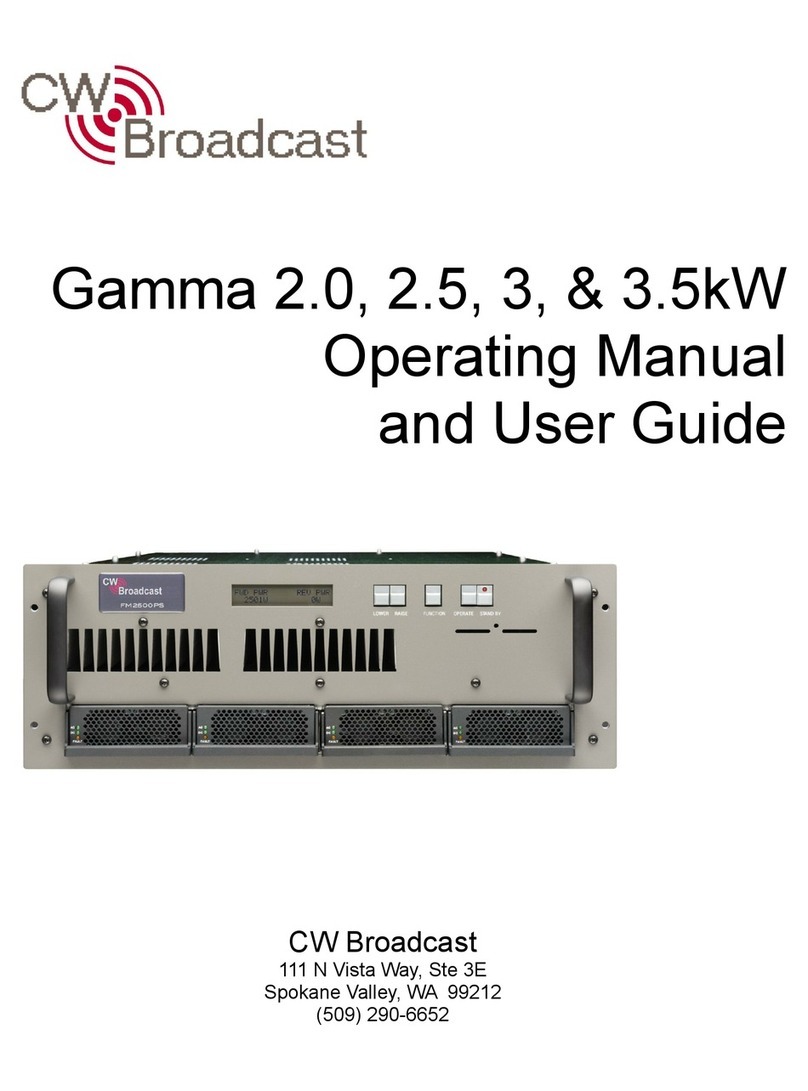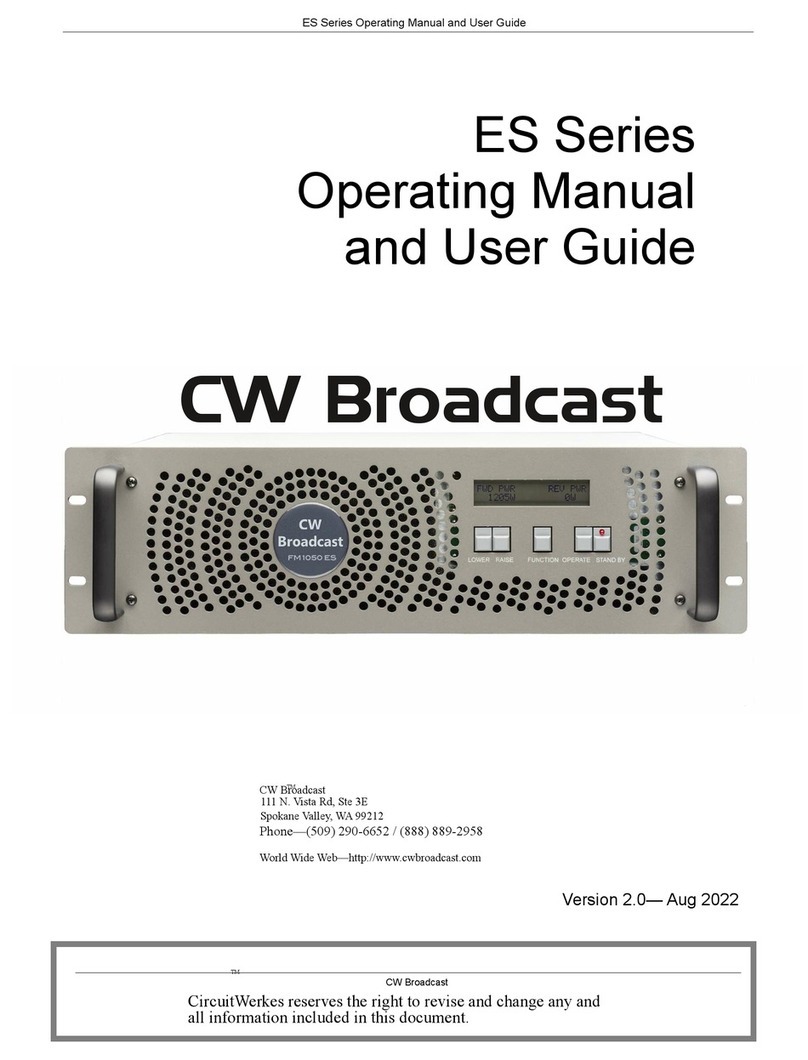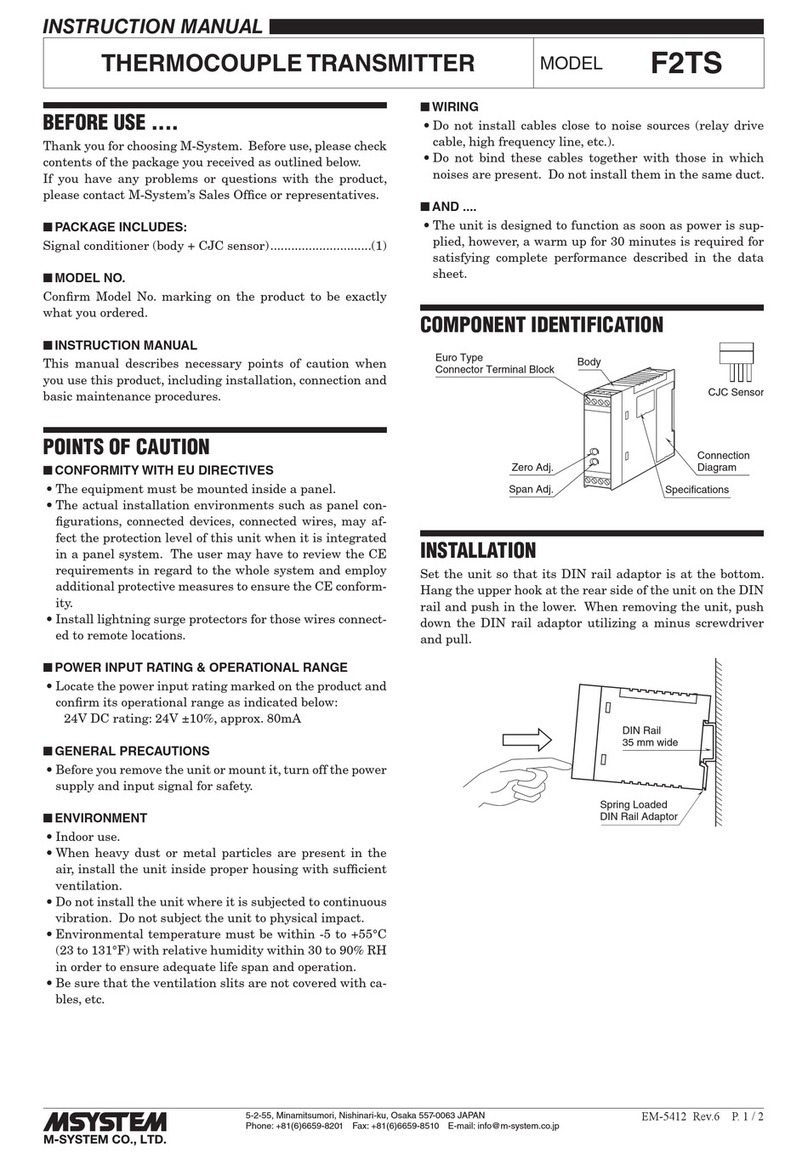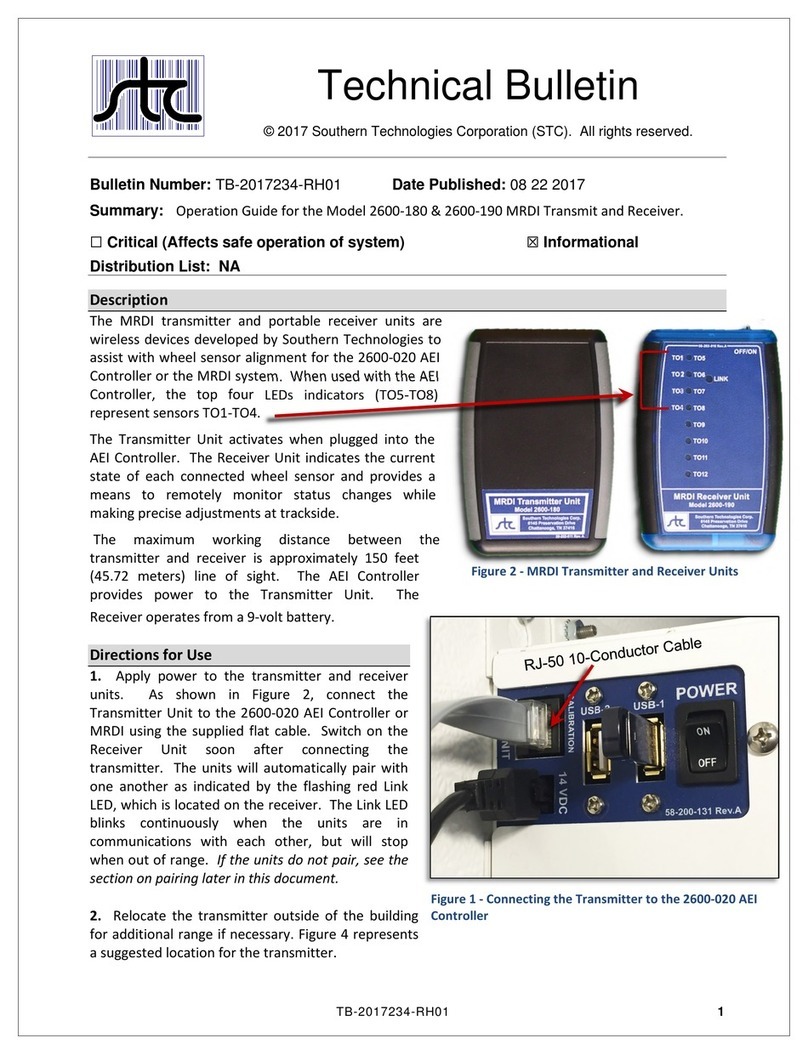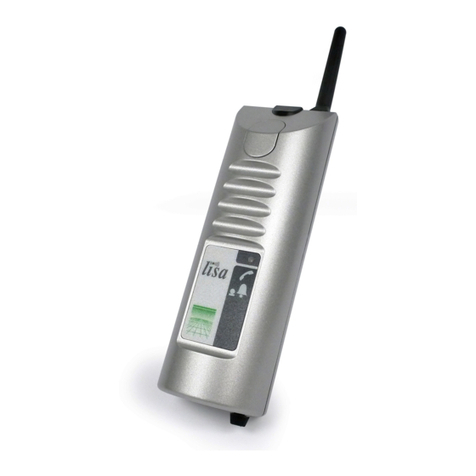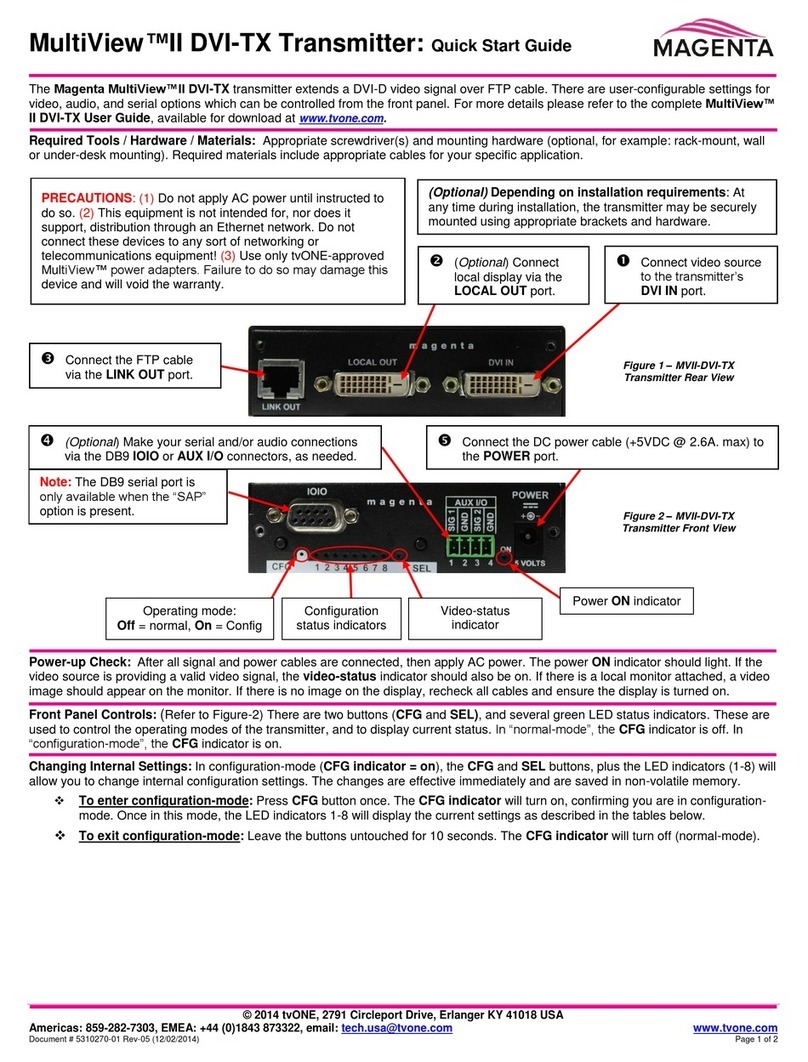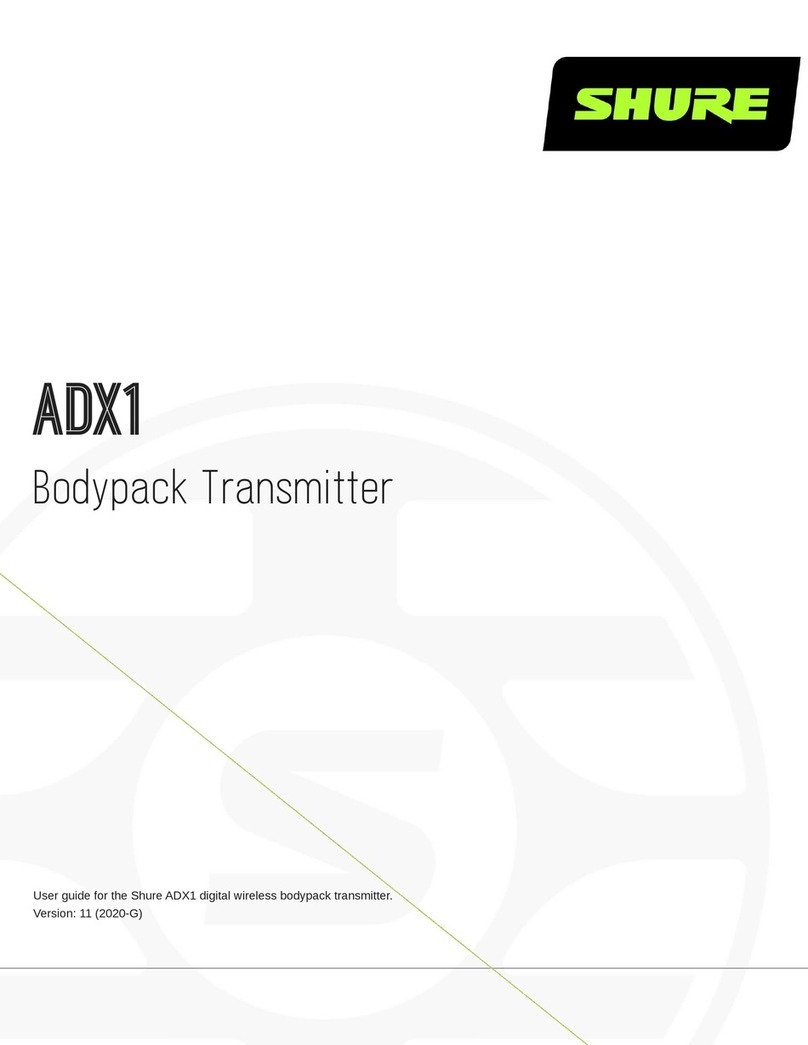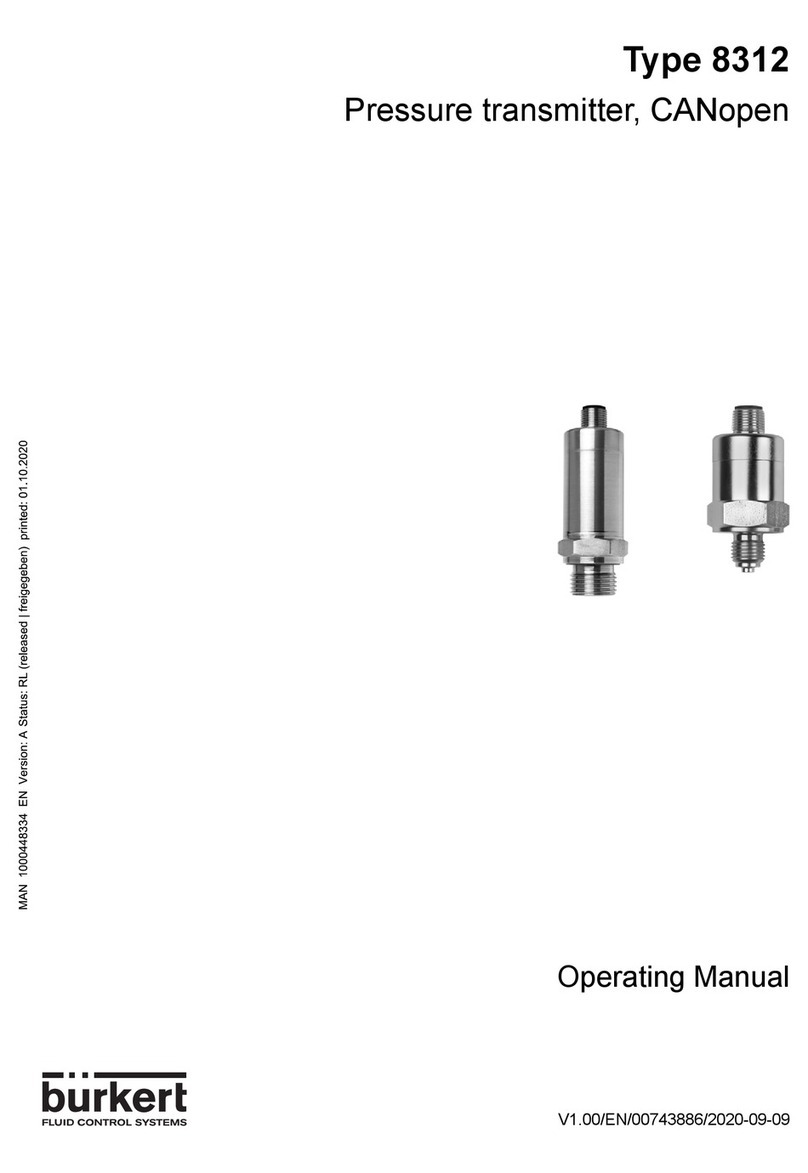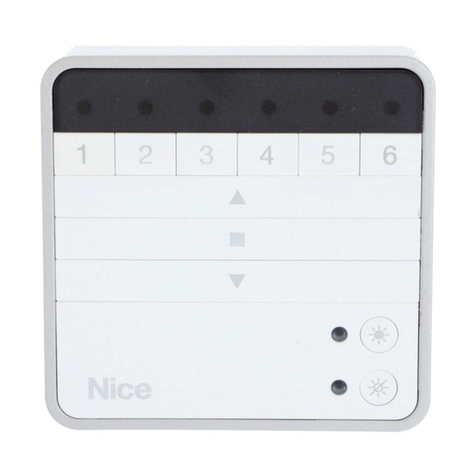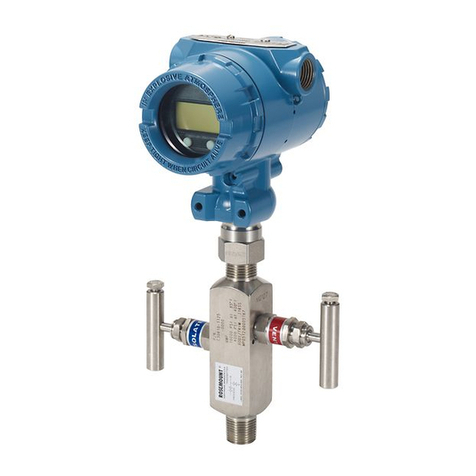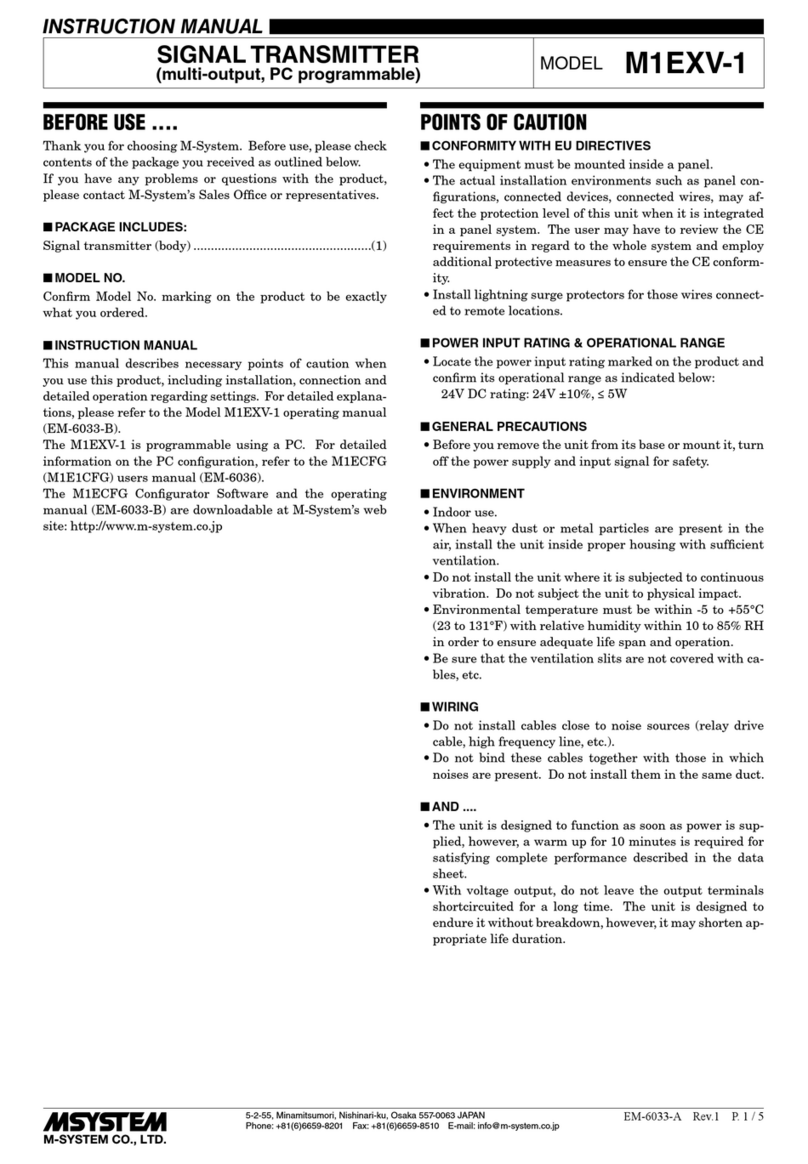CircuitWerkes CW Broadcast FM1200ES Guide

FM1200ES Transmitter
Operating Manual
and User Guide
CW Broadcast
111 N. Vista Rd, Ste 3E
Spokane Valley, WA 99212
P one—(509) 290-6652 / (888) 889-2958
Online— ttp://www.cwbroadcast.com
CircuitWerkes reserves t e rig t to revise and c ange any and all information included in t is document.
Version 2.0— Aug 2022
CW Broadcast
FM Series Operating Manual and User Guide
C
Broadcast

Copyrig t © 2022-2023 CW Broadcast
ALL RIGHT S RESERVED. No part of t is publication may be reproduced in any form, by
p otocopy, microfilm, retrieval system, or by any ot er means now known or ereafter invented wit out
t e prior written permission of CircuitWerkes, Inc.
T e information in t is publication as been carefully c ecked and is believed to be accurate. However,
CW Broadcast/CircuitWerkes, Inc. assumes no responsibility for inaccuracies. We retain t e rig t to make c anges to t is
publication at any time wit out prior notice. CircuitWerkes, Inc. does not assume any liability arising from t e
application or use of t is publication or t e product(s) described erein.
RESTRICTED RIGHTS LEGEND: Use, duplication, or disclosure by t e United States Government
is subject to t e restrictions set fort in DFARS 252.227-7013 (c)(1)(ii) and FAR 52.227-19
CircuitWerkes FM Customer Support
Telep one:(509) 290-6652
E-mail [email protected]
Web Site: ttp://www.cwbroadcast.com
:
arranty Service:
ES Series transmitters are warranted for a period of 24 months from date of purchase. During
the warranty period we will repair or replace the transmitter, at our sole discretion. No refunds
will be issued after 90 days. Contact customer service to obtain an RMA for your product.
This warranty does not cover acts of God such as lightning. Damage caused by misuse or
shipping is excluded from the warranty. C Broadcast will not warranty the product due to
misuse, accident, neglect, and improper installation or operation, or abuse such as immersion in
water or direct exposure to the natural elements.
The Limited arranty covers parts and labor to the original purchaser as outlined on purchase
invoice for use in the United States of America. Customer is responsible for shipping to us. e
will prepay ground shipping back to the customer.
---These transmitters are not recommended for use as a
replacement IPA—
Proper installation includes A/C line surge suppression, lightning protection and proper
grounding of the entire transmitter, and any other recommendations designated in this
Operating Manual.
CW Broadcast® is a trademark of CircuitWerkes, Inc.
All ot er trademarks, servicemarks, or registered trademarks used in t is publication are t e property of t eir respective
owners.

Safety Instructions
To maximize user safety and ensure corr ect device operation, all instructions con-
tained in t is section s ould be read carefully.
Before Applying Power
Verify t at t e line voltage is 220VAC.
Ground the Exciter
Caution: It is important t at t e user observeall warnings and instructions t at
are on t e device and contained in t is manual.
Warning:
DO NOT OPERATE IN AN EXPLOSIVE ATMOSPHERE
Operation of t e transmitter in t e presen ce of flammable gass es or fumes can
endanger persons proximate to t e site of operation.
Caution: NO NOT REMOVE THE TRANSMITTER COVER
Removal of t e exciter cover will invalidate t e Warranty.
Component replacement and internal adjustments must be
made only by CW Broadcast qualified service personnel.
To minimize s ock azard, t e exciter c assis must be connected to an electrical
ground, t e exciter must be connected to t e AC power mains t roug a t ree-
conductor power cable, wit t e t ird wire connected to an electrical ground (safety
ground) at t e power outlet. Any interr uption of t e protective (grounding)
conductor or disconnection of t e protective eart terminal will cause a potential
s ock azard t at could result in personal injury. If t e exciter is to be energized by
any ot er source be certain t at t e c assis is connected to a separate safety ground.

Fuses
Only fuses wit t e same required current, voltage rating, and specified type (nor-
mal blow, time delay, etc.) s ould be use d. Do not use repaired fuses or s ort-cir-
cuited fuse olders. To do so could cause a s ock or fire azard.
Output Connector
Electrostatic Discharge (ESD)
A sudden disc arge of electrostatic electric ity can destroy static -sensitive devices
or micro-circuitry. Proper packaging and grounding t ec niques are necessary pre-
cautions to prevent damage. Always take industry-standard precautions.
Grounding Methods
Guard against electrostatic damage at workstations by following t ese steps:
1. Cover workstations wit approved anti-static material. Provide a wrist strap connect-
ed to a work surface and properly grounded tools and equipment.
2. Use anti-static mats, eel straps, or air ionizers to give added protection.
3. Handle electrostatic-sensitive components, boards, and assemblies by t e case or t e
PCB edge.
4. Avoid contact wit pins, leads, or circuitry.
5. Turn off power and input si gnals before inserting and removing connectors or test
equipment.
6. Keep t e work area free of non-conductive materials suc as ordinary plastic assem-
bly aids and Styrofoam.
7. Use field service tools, suc as cutters, screwdrivers, and vacuums t at are conduc-
tive.
Warning:
T e 3-16 output connector carries dangerously ig RF voltages
t at present s ock and burn azards. Never operate t e exciter wit -
out properly terminating t e output connector in eit er an adequately rated load
or antenna.

General Safety Rules
•T e device must be used in acco rdance wit t e instructions for use.
•Electrical installations in t e room must co rrespond to t e requireme nts of respective regu-
lations.
•Take care t at t ere are no cabl es, particularly mains cables, in areas w ere persons can trip
over t em.
•Do not use a mains connection in sockets s ar ed by a number of ot er power consumers. Do
not use an extension cable.
•Only use t e mains cable supplied.
•T e unit is completely disconnected from t e pow er source only w en t e power cord is dis-
connected from t e power source. T erefore t e power cord and its connectors must always
remain easily accessible.
•Do not set up t e device in t e proximity of eat sources or in a da mp location. Make sure
t e device as adequate ventilation.
•All plugs on t e connection cables must be screwed or locked to t e c assis ousing.
•T e device is designed to be used in orizontal position only.
•T e device is no longer safe to operate w en t e device as visible damage or t e device no
longer functions.
•In case of system malfunction or visible damage to t e FM 500ES, t e device must be s ut
down and secured against unintentional operation.
•Repairs may only be carried out by a person aut orized by CW Broadcast.
•If extensions are made to t e transmitter, t e le gal stipulations and t e device specifications
must be observed.
•T e transmitter must be switc ed off and t e line cord disconnected from t e AC source
w en removing t e top cover.

Preface
FM1200ES FM Stereo Broadcast Transmitter
T is document, ES Operating Manual and User Guide, provides instructions on ow
to install, configure, power up, and perform diagnostics on t e 1200 Watt CW
Broadcast ES FM Broadcast Transmitter (see p oto below), an easy-to-use and
versatile system t at can be used in eit er stand-alone or backup mode. T e
information contained wit in is intended for an experienced system operator wit a
knowledge of ig -performance broadcast transmission systems. T e 3RU- ig
(3.5”) transmitter designed to fit a standard is 19” rack Optional rack-mount slides
are also available.

Key features of t e ES FM Stereo Broadcast Transmitter include:
•Totally solid-state no-tune construction
•Wide input range from 180 to 264 VAC
•Built-in field-programmable FSK ID for translator use
•Remote-control interface
•Optional built-in stereo encoder
•Rugged design wit stands up to 5G forces and 50°C
•Meets or exceeds all FCC and CCIR standards
•Designed and manufactured in t e United States
ebsite Information
CW Broadcast corporate and product information may be accessed on t e World Wide Web
by browsing t e website ttp://www.CW Broadcastpower.com
.
Your Comments are elcome
We are interested in improving our docu mentation and welcome your comments and
suggestions. You can email your comments to us at docfeedback@CW Broadcast.com
.
Please include t e document part numbe r in t e subject line of your email.
Frequency stability for eac unit is ensured by using direct-to c annel digital
modulation. All units incorporate over-temperature protection and VSWR foldback to
automatically reduce power output to safe operating levels Switc -mode power
supplies provide consistent performance even w en t ere are frequent power outages
and voltage fluctuations t at make stressful demands of power dependence. An
overview and specifications of t e ES FM Stereo Broadcast Transmitters is given in
C apter 1, "Overview and Specifications", of t is manual.

Notes, Cautions, arnings, and Sidebars
T e following icons and formatted text are included in t is document for t e reasons
described:
Note: A note provides additional information concerning t e procedure or action
being described.
Caution: A caution describes a procedure or action t at may result in injury to t e op-
erator or equipment. T is may involve—butis not restricted to— eavy equipment or
s arp objects. To reduce t e risk, follow te instructions accompanying t is symbol.
Warning: A warning describes a procedure or ac tion t at may cause injury to t e
operator or equipment as a result of azardous voltages. To reduce t e risk of elec-
trical s ock and danger, follow t e instructions accompanying t is symbol.
Sidebar: A “sidebar” adds detail to t e sect ion wit in w ic it is placed,
but is not absolutely vital to t e description or procedure of t e section.

1FM150ESFMStereoBroadcastTransmitter
Overview and Specifications
1.1Overview
Figure1-1. ES Series Transmitter
General
Section
C apter
The 3RU-high (5.25”) ES Series FM Stereo Broadcast Transmitter is
designed to fit a standard 19” rack and is provided with rack-mount left and
right brackets and handles. Optional rack-mount slides are also available.
The ES Series are rugged enough to withstand extreme shock (up to 5G),
temperature (up to 50°C), and EMI such as that associated with
broadcasting from remote rugged environments. (see
Figure 1-1; a block diagram is given in Figure 1-2, page 1-2). The ES
Series supports Mono, ideband Stereo (left and right) and SCA inputs,
ideal for a variety of commercial and dedicated stereo broadcast
transmission applications.

T e transmitter is designed wit in a 3RU- ig (5.25”) form-factor t at is 18”
deep (including t e front panel and rear protective flanges; t e c assis body itself
is 13” deep) and 17” (43.2 cm) wide (19” including t e front panel to fit a standard-
size rack).
Features on t e transmitter front panel are s own .
Figure 1-2. transmitter System Block Diagram
Figure 1-3. transmitter Front Panel
Air Vent (Filter Behind)
Standby Key
Operate Key
Handle
Meter Function Key
Lower Key Raise Key
LCD Display
Handle
Forward & Reverse RF Power
Deviation
Final Output Volts & Amperes

Major internal components of t e transmitter can be seen in t e open top view (cover
removed) displayed in Figure 1-4 ( A). Features on t e transmitter rear panel are
s own in Figure 1-4 (B).
AC Power Supplies (Under)
Atransmitter Top View (Cover Off)
AC Input
Composite Input
SCA/RDS Input
Right Stereo (or Mono)
Left Stereo Accessory Connecter
RF Output to Antenna
7-16 DIN Standard or 7/8” Flange (Shown)
Front
High power amplifiers
Harmonic Filter
Control and
Metering Board Control Board
Exciter

1.2Specifications
1.2.1General
Table1-1 lists general specifications for t e transmitter.
Table 1-1. transmitter General Specifications
Parameter Description
Dimensions ζ5.25” (3RU) high
ζ17” (43.2 cm) wide (19” including the front panel)
ζ
16” deep (including the front panel and rear protective flanges;
the chassis body itself is 13” deep)
eight Total shipping weight is under 33.5 pounds (15.2 kg) and includes the following:
ζ
Chassis = under 24 pounds (10.9 kg), including AC power supplies
ζ
Add 8.5 pounds (4 kg) for the shipping container and one AC power cord
ζThe manual and associated shipping paperwork weigh approximately 1 lb
(0.5 kg)
19” Rack-Mountable
with Slide capability
ζLeft and right rack-mount tabs and handlesare attached directly to the chas-
sis. Rack-mount slides are optional.
Temperature
Operating:
Non-Operating:
ζ0°C to +50°C
ζ–40°C to +70°C
Relative Humidity
Operating:
Non-Operating:
ζ8% to 90% non-condensing
ζ5% to 95% non-condensing
Maximum et Bulb
Operating:
Non-Operating:
ζ27°C, non-condensing
ζ35°C, non-condensing
Altitude
Operating:
Non-Operating
ζ0 to 10,000 feet above sea level
ζ0 to 40,000 feet above sea level

1.2.2Electrical
Table1-2 lists t e electrical specifications for t e transmitter.
1.2.2.1System Power
Table 1-2. transmitter Electrical Specifications
Parameter Description
Frequency Range ζ87.7 MHz to 108 MHz
Audio Input Impedance ζ600 ohms
Audio Input Level (Composite) ζ–10 dBm
Audio Input Level R & L Stereo Encoder ( optional)z –10 dBm
Frequency Response (Composite) ζ20 Hz to 15(90) KHz
Pre-Emphasis ζ50 or 75 uS
Harmonic Distortion ζ< 0.25% max
Signal-to-Noise Ratio ζ> 80 dB rms
RF Output Impedance ζ50 ohms
Output Connector ζ3-16 DIN female
RF Power Output ζ
Harmonic Attenuation ζ< –70 dB
Power Requirements ζ88–264 VAC, internally fused
Fuse ζ
AC power supply is auto-ranging single-phase AC input from a 180 to 264
VAC (47 to 63 Hertz)
Although the transmitter will accept 115V, it will likely not be able to achieve
full power with less than 200V due to amperage limitations at high power.
550 (330 300ES 165 150ES and 55 50ES)

1.2.3Environmental
1.2.3.1 Shock
T e transmitter is designed to survive an elevated s ock environment. All structural
components are welded toget er, enabling t e system to survive a maximum 3-axis
s ock load of 5G at 20-msec duration.
1.2.3.2Electrostatic Discharge
T e transmitter is designed to tolerate el ectrostatic pulses up to 15 kilovolts (KV)
wit no impact on system operation.
1.2.3.3 Noise Level
Typical noise levels emitted by t e transmitter are outlined in Table1-3 . T e c assis
is installed wit two 60-mm fans mounted side-by-side at t e rear of t e system. In
addition, eac AC power supply as its own cooling fan.
Table 1-3. Typical Noise Levels of the transmitter
Measured at: 1 Meter 2 Meters
Front 66.24 dB 57.57 dB
Rear 61.53 dB 57.93 dB

1.3Packaging and Shipping
T e FM1200ES Transmitter is packaged in a reusable s ipping
container. Approximate weig t of an empty container and one (1) AC power cord is
9 pounds (4 kg).
T e approximate weig t of an transmitter is under 25 pounds.
T e approximate weig t of a manual and associated s ipping paperwork is one (1)
pound (0.5 kg).
T erefore, bot t e s ipping container and a fully installed transmitter including
power cord, manual, and associated paperwork, weig under 35 pounds.
1.3.1Rack-Mount Slides ( Optional)
Rack-Mount slides (optional) can be installed on eac side of t e transmitter for t e
purpose of sliding t e unit easily in and out of a 19” ra ck using t e convenient front
andles. Rack-mount slides s ould be ordered at t e time of purc ase.
To learn ow to install r ack-mount slides, refer to A ppendix B, “Rack-Mount Slide
Installation”, on page B-1.

2.2Removing the Protective Top Cover
Open t e transmitter FM transmitter as follows
1. Remove t e protective top cover of t e transmitter by loosening t e two P il-
lips screws on eac side of t e c assis (see Figure 2-1 ).
2. Store t e cover and screws in a safe place until replaced.
Warning: Make sure t at t e AC power cord is removed from t e AC input con-
nector on t e rear of t e transmitter before removing t e protective top cover.
Figure 2-1. transmitter Right-Side Top Cover Phillips Screws
Phillips Screws (4)
This side and far side
ES Series Operating Manual and User Guide

2. Remove t e air filter (see Figure 2-6), t en carefully was it wit mild soap
and water.
3. C eck t at t e exposed air vent oles are unobstructed.
4. After t e air filter as been dried, replace it and t e front panel. Make sure t e
front panel screws are fully tig tened.
Figure 2-6. Remove the Exposed Air Filter
Figure 2-7. Make Sure the Air Vent Holes are Unobstructed
Air Filter
Air Vent
2.5Cleaning the Air Filter
Accessing t e air filter requires removing t e front panel of t e transmitter.
1. Remove t e 4 P illips screws on t e transmitter front panel (see Figure 2-5).
Figure 2-5. Remove the Front Panel Screws to Access the Air Filter
Screw
Screw
Screw
Screw

2.6Rack Mounts
Rack-mount brackets (or flanges)—w ic are built into t e c assis and t erefore not
removable—are used to secure t e transmitter c assis to a 19” rack.
Rack-mount slides are used to pull t e transmitter away from t e rack for easier
access.
2.6.1Mounting Brackets
Use t e following steps to secure a transmitter c assis to a 19” rack.
1. Wit t e elp of a sec ond person, carefully insert t e transmitter c assis into
t e 19” rack (see Figure 2-8).
2. Using four 10-32 screws wit corresponding lock was ers and nuts,
attac t e transmitter c assis to t e 19” rack t roug t e four mounding oles
of t e mounting brackets.
Figure 2-8. Left and Right Rack-Mount Brackets
19” Rack
Right
Bracket
Mounting
Left
Bracket
Mounting
Caution: Make sure to tig ten eac moun ting screw to a ssure t at t e
transmitter c assis is firmly installed onto t e 19” rack.

2.6.2Rack-Mount Slides ( Optional )
Rack-Mount Slides can be mounted on eac side of t e transmitter FM Stereo Broad-
cast Transmitter for t e purpose of sliding t e unit in and out of a rack. Mounting
slides are optional and s ould be ordered at t e time your system is purc ased.
To learn ow to install r ack-mount slides, refer to A ppendix B, “Rack-Mount Slide
Installation”.
Caution: Any screws used to mount a slide to a transmitter c assis must not exceed
a lengt of 3/8” to prevent excessive penetration of t e c assis.

2FM150ES
3
Operation
T is c apter describes:
•How to set up t e transmitter system to begin operation
•How to turn t e transmitter on and off
•How to monitor and c ange t e operational settings of t e transmitter
3.1Set Up the System
To successfully operate t e FM1200ES FM Stereo Broadcast Tran smitter, an antenna
(or power amplifier) and an a udio source must first be connected to t e system, as
outlined in t e following steps:
1. Connect t e antenna or power amplifie r input to t e RF output connector on
t e rear panel of t e transmitter (see Figure3-1 on page3-2).
2. Connect t e audio input to one of t e following connectors t e rear panel:
•Composite Input (ensure t e Stereo encoder is disabled)
• Balanced Mono Input
•Balanced Stereo Left and Rig t (if equipped wit stereo encoder)
Operation
Section
C apter
Table of contents
Other CircuitWerkes Transmitter manuals
Popular Transmitter manuals by other brands
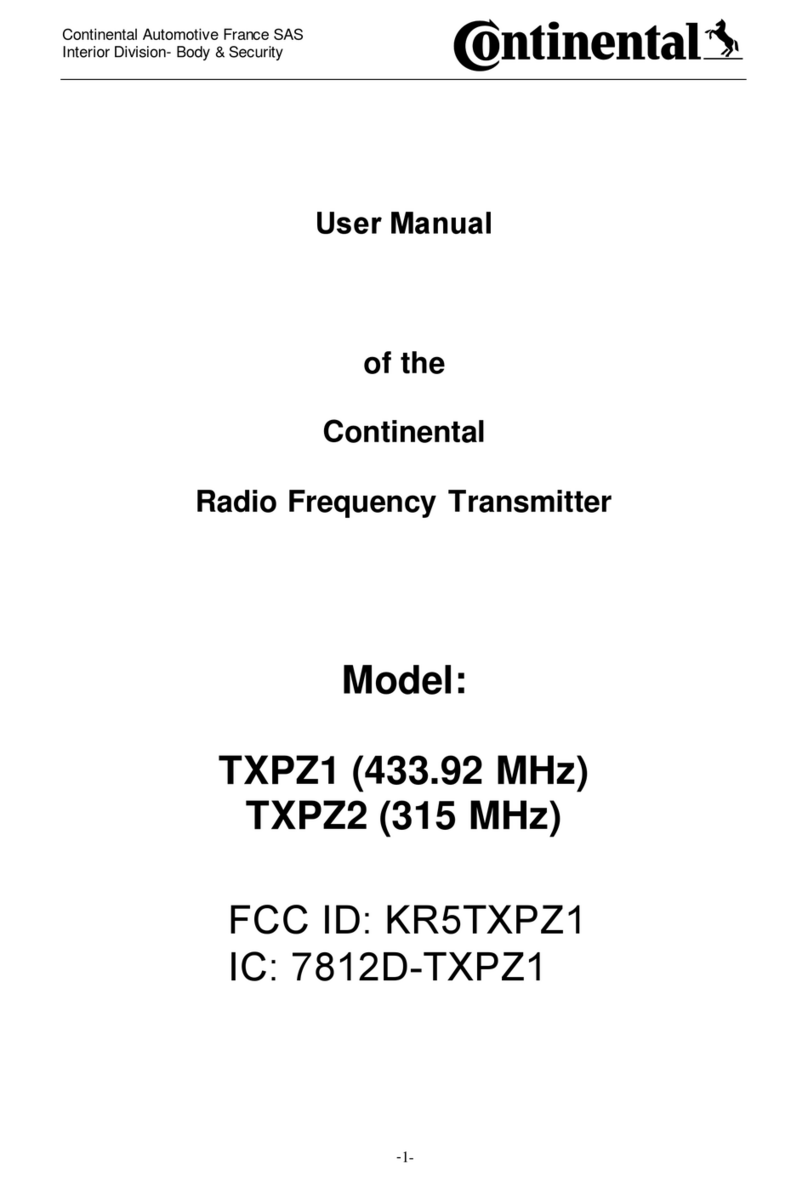
Continental Refrigerator
Continental Refrigerator TXPZ1 user manual
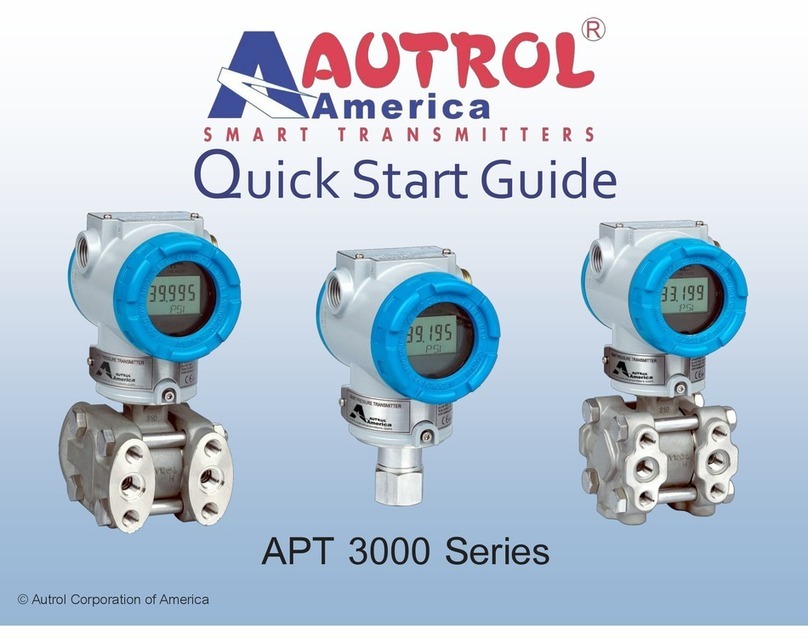
Autrol
Autrol APT 3000 Series quick start guide
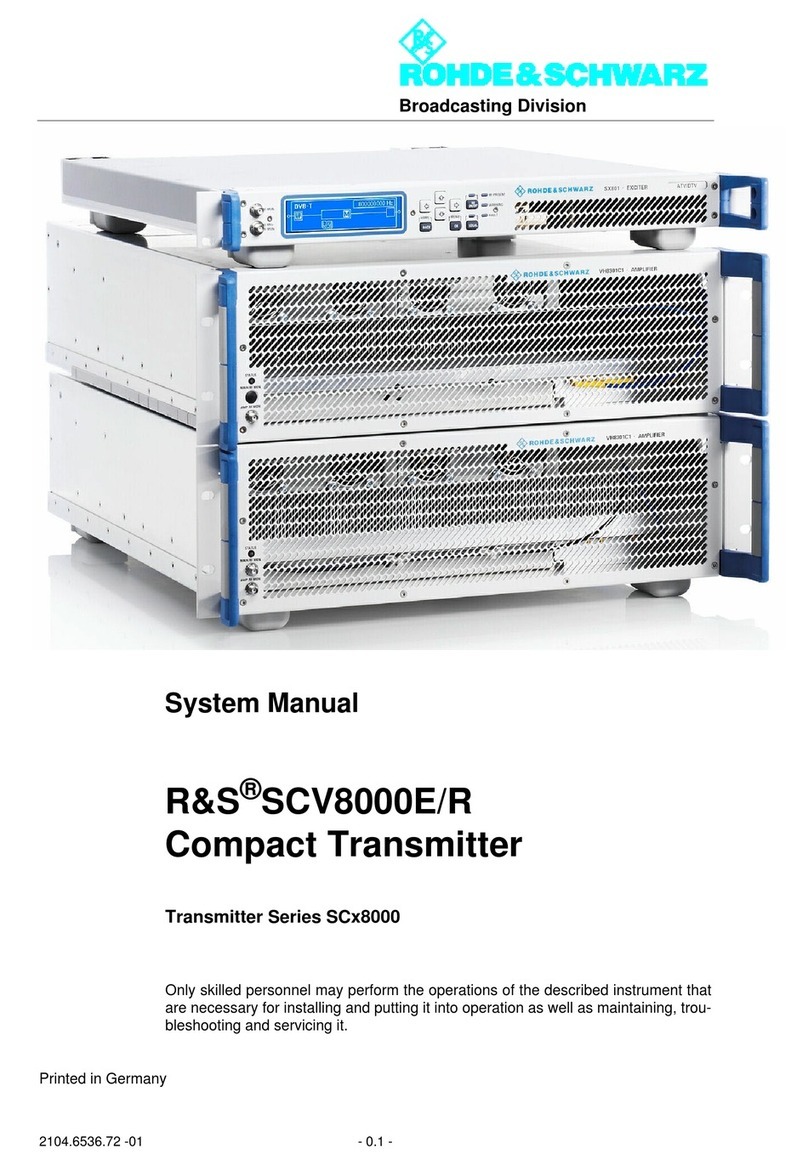
Rohde & Schwarz
Rohde & Schwarz SCV8000E/R System manual
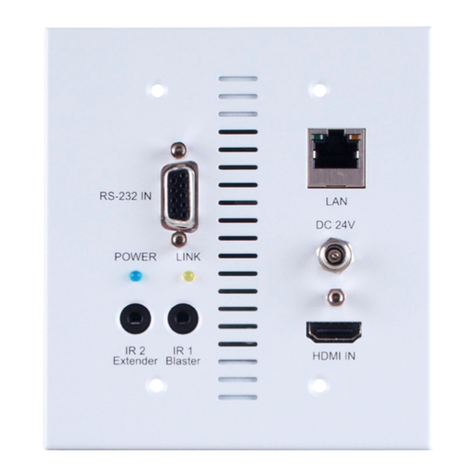
CYP
CYP CH-507TXWPUS Operation manual

Endress+Hauser
Endress+Hauser Cerabar S PMC71 operating instructions

Setra Systems
Setra Systems C290 operating instructions
